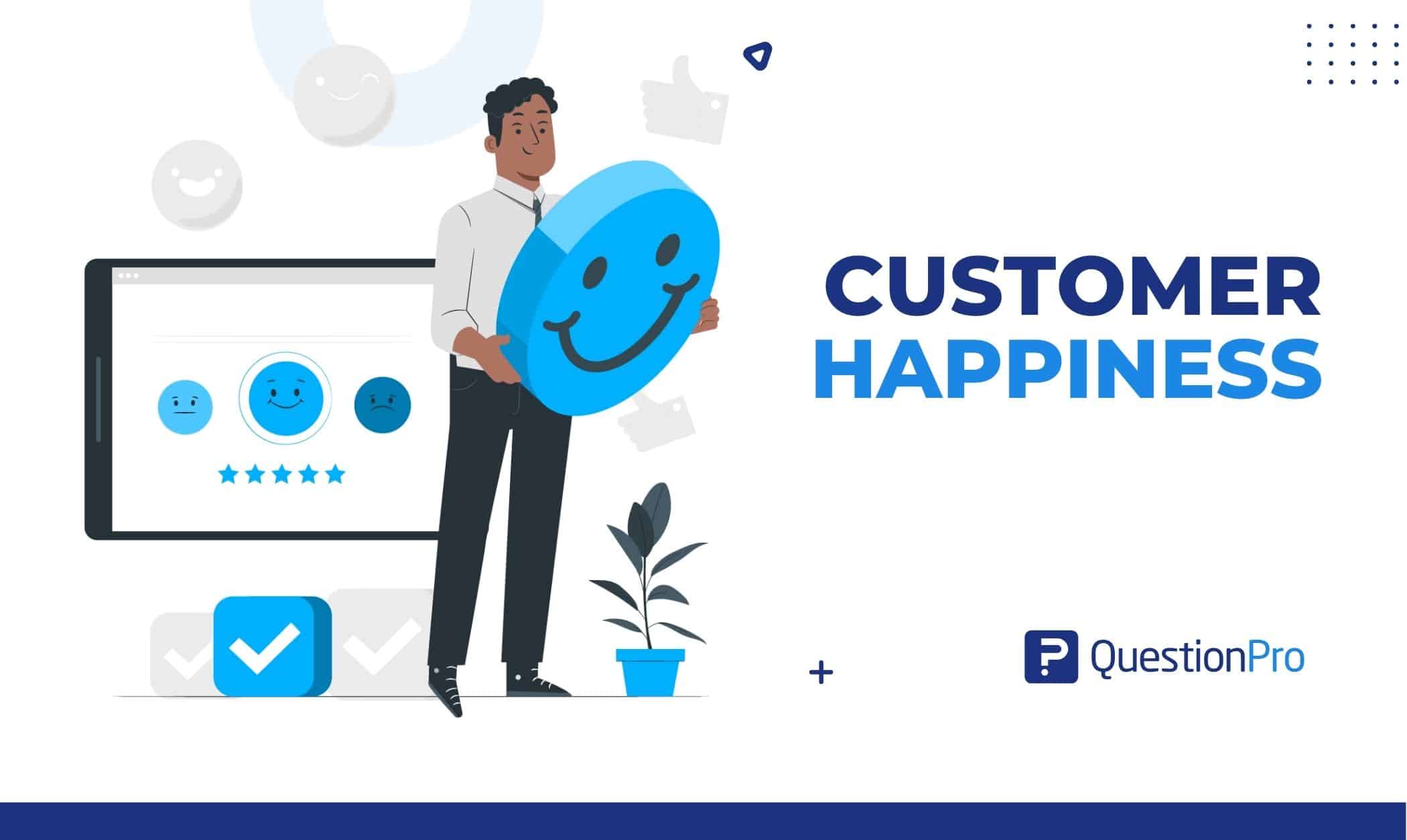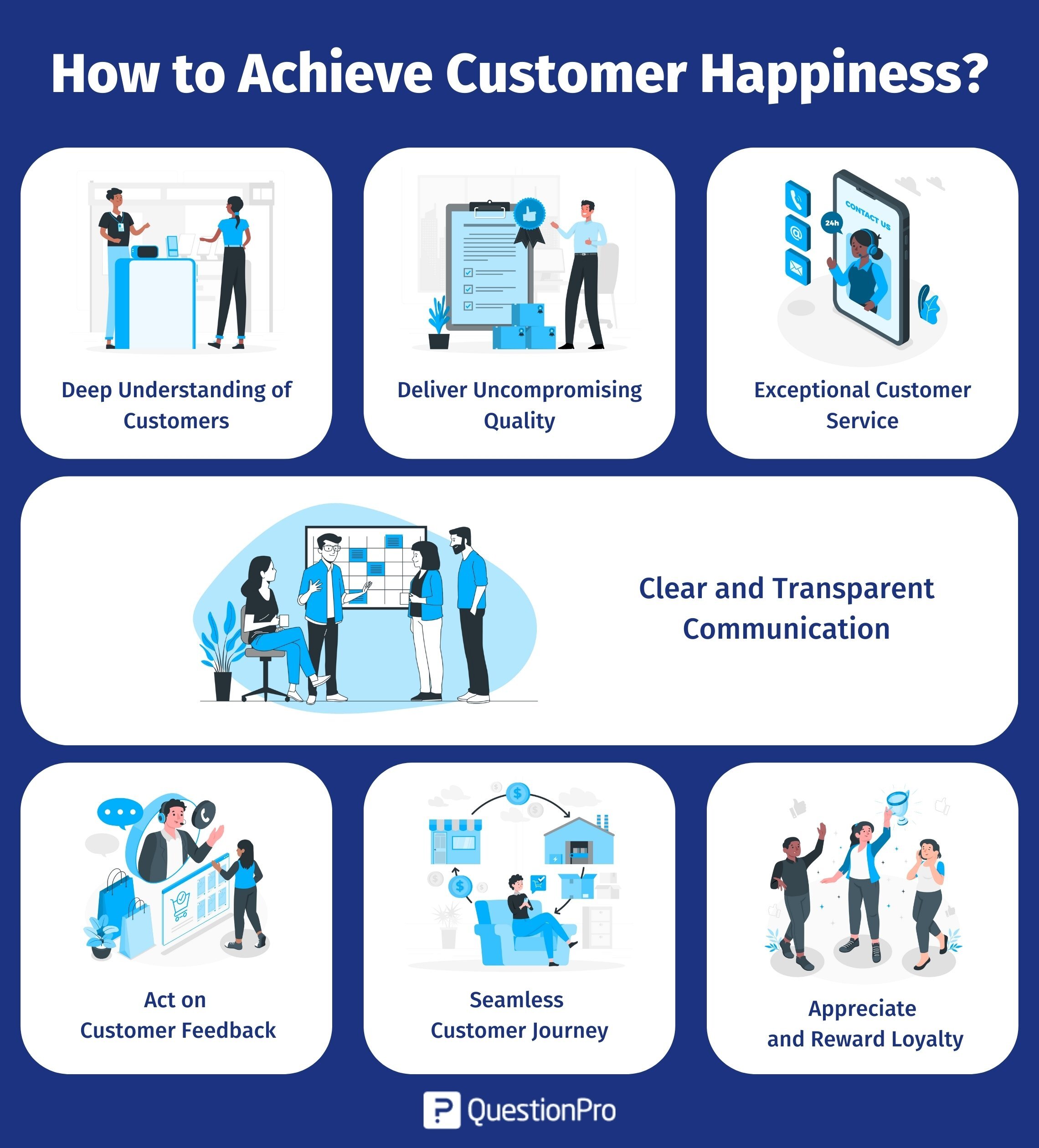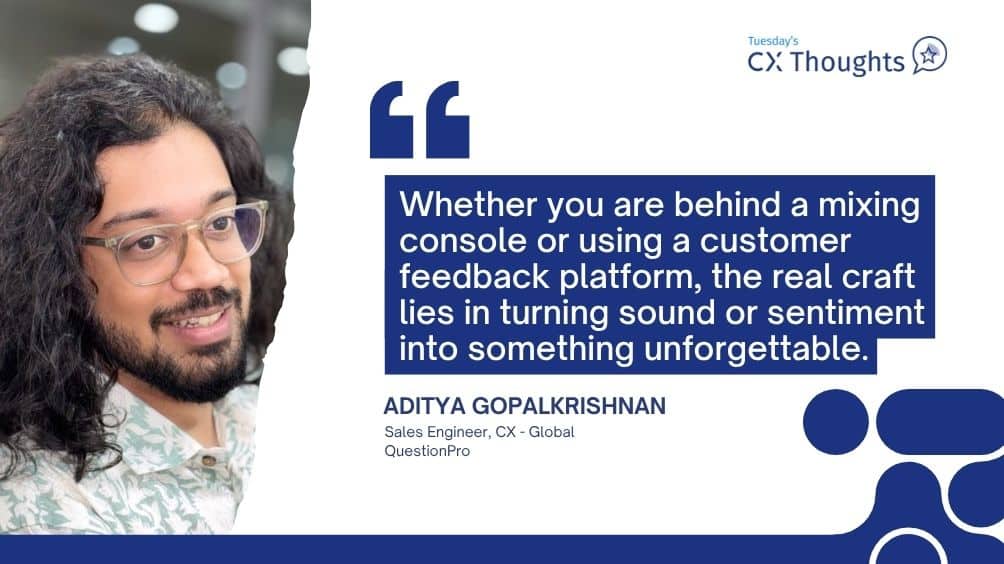
It can be difficult to win customers’ hearts and minds. What do they want? Knowing what they want and keeping customers happy with your products or services is important. Customer happiness is one of the most important things that helps a business grow. A happy customer is considered the main revenue source for any business.
Attracting a new customer costs 5x more than keeping an old one. It’s never too late to start taking better care of your customers because a happy customer is a better way to market your business than any ad. It’s easy to keep your customers happy. Care about their needs and feelings at every step of their journey and be there for them.
Here, we will discuss the definition of customer happiness, why it is important, and how to measure and achieve it. Keep reading to learn more.
What is Customer Happiness?
Customer happiness is the level of consumer loyalty and customer satisfaction after engaging with your product, services, or staff. It’s how your customers feel when their needs are met regularly, at the right time, and in the right way.
People who are happy with your business will stick with you for a long time. Also, a happy customer is more likely to stay with you. When customers find a business they can trust, they tell their friends and coworkers about it.
You may also check out this guide to learn how to build your own Customer Journey Map.
Importance of Customer Happiness
Keeping your customer happy is important because it helps problem-solve, prevents churn, and identifies happy customers who might promote your brand. Below, we will explore some key importance of clients’ happiness:
Helps to Earn Customer’s Loyalty
If your customers are happy, it’s a sign that they might stick around and buy from you for the rest of their lives.
If you make your customers happy with your products and services, they’ll be more loyal to you and more likely to promote your brand by telling their family and friends about how great your business is. It can take years to get a customer to stick with you, so make sure that every interaction they have with your business is good.
Make Your Customers Remember
You want your customers to feel good about your business and remember you when they leave. You really don’t want them to be unhappy when they leave.
One analysis found that an unhappy customer will tell between 9 and 15 other people about their bad experience. About 13% of unhappy customers tell more than 20 people. That gives your business a lot of bad vibes.
Negative comments from word of mouth or online reviews can be challenging for your company to fight. Because of social media, it’s easy for bad customer experience comments to spread. When your customers are happy, you don’t often have to deal with people who don’t like what you do.
What to do if a customer isn’t happy? Try to see the situation from their point of view and do what you can to help. Listen with understanding and care.
Help you Beat the Competition
It’s a safe bet that if you invest in customer happiness, you will beat your competition in terms of business.
Make sure your customers are happy if you want to stay ahead of the competition. Think about the restaurant that goes above and beyond to make its customers feel special by taking care of their special requests with grace. You may be sure that the customer will talk to their friends, recall how happy the restaurant made them, and visit again.
Improves Customer Lifetime Value
When you invest in customer happiness, you increase the lifetime value of your customers. What is it? It predicts your net profit from your connection with one customer. According to research published by Info Quest, a completely satisfied customer generates 2.6 times as much income as a slightly happy customer.
Also, a pleased customer brings in 14 times more money than a somewhat unhappy customer. So, the longer your customer is happy, the more likely their lifetime value will increase.
Learn more about why understanding your Customer Journey transforms your CX program.
How to Measure Customer Happiness?
Understanding and prioritizing customer happiness is important for sustained success. Happy customers contribute to your bottom line and become enthusiastic advocates for your brand. To effectively understand and measure customer satisfaction, businesses can employ various methods. Here, we’ll explore three key ways:
- Customer satisfaction surveys
- Social media sentiment analysis
- Net promoter scores
Let’s examine each option.
1. Customer Satisfaction Surveys
One of the most direct ways to measure customer satisfaction is through well-crafted customer satisfaction surveys. These surveys, often conducted through online platforms or email, allow businesses to collect structured feedback from their customers. Common metrics include NPS and CSAT.
- Net Promoter Score: Customers are asked a single question – “How likely are you to recommend our product/service to a friend or colleague?” The responses categorize customers into Promoters, Passives, and Detractors, clearly indicating overall satisfaction.
- Customer Satisfaction (CSAT): Customers rate their satisfaction on a scale, typically from 1 to 5 or 1 to 10, based on their experience with a product or service. This straightforward metric helps businesses understand the immediate sentiment of their customers.
2. Net Promoter Score
Net Promoter Score is a widely used metric for measuring customer loyalty and satisfaction. It goes beyond a simple rating, aiming to identify customers who are not just satisfied but actively willing to recommend a brand.
- Promoters, Passives, Detractors: By categorizing customers based on their likelihood to recommend, businesses can focus on turning Passives into Promoters and addressing the concerns of Detractors.
- Continuous Feedback: NPS can be implemented at various touchpoints in the customer journey, providing continuous feedback. This allows businesses to pinpoint specific areas that contribute to customer satisfaction or dissatisfaction.
- Benchmarking: Comparing NPS with industry benchmarks provides context and helps businesses understand their competitive position in terms of customer happiness.
Incorporating NPS into regular assessments enables businesses to track changes in customer loyalty and identify patterns that can inform strategic decisions.
3. Social Media Sentiment Analysis
Social media platforms serve as powerful channels for customers to express their opinions and experiences. Social media sentiment analysis involves monitoring these platforms to gauge the overall sentiment surrounding a brand.
- Monitoring Mentions: Businesses can track brand mentions, comments, and hashtags related to their products or services across various social media platforms. Analyzing the tone of these interactions provides insights into customer sentiments.
- Engagement Metrics: Likes, shares, and comments on social media posts can indicate the level of customer engagement and satisfaction. A positive and active online community often correlates with a satisfied customer base.
- Addressing Concerns: Promptly addressing negative comments or issues raised on social media resolves individual problems and demonstrates a commitment to customer satisfaction to a wider audience.
Social media sentiment analysis is a dynamic and real-time method that complements traditional survey approaches, offering a more immediate pulse on customer happiness.
How to Achieve Customer Happiness?
Customer happiness is not just a goal; it’s a journey that requires dedication and a customer-centric mindset. Here are practical steps to help you achieve and maintain customer happiness:

Deep Understanding of Customers
Develop a profound understanding of your customers by actively engaging with them. Learn about their needs, preferences, and challenges. This knowledge will serve as the foundation for crafting personalized experiences that resonate with each individual.
Deliver Uncompromising Quality
Strive for excellence in your products or services. Ensure that every offering reflects a commitment to quality, going beyond meeting expectations to consistently exceed them. High-quality offerings build trust and contribute to lasting customer satisfaction.
Exceptional Customer Service
Elevate customer service to an art form. Be responsive, empathetic, and proactive in addressing customer queries or concerns. Going above and beyond in your customer service efforts resolves issues and creates positive and memorable experiences.
Clear and Transparent Communication
Communication is key to a successful customer relationship. Maintain transparency in your communications, keeping customers informed about changes, updates, and relevant information. Clear communication builds trust and helps manage customer expectations.
Act on Customer Feedback
Encourage a culture of feedback and actively listen to your customers. Collect insights through surveys, reviews, and social media channels. Analyze this feedback meticulously and use it to make informed decisions, demonstrating your commitment to continuous improvement.
Seamless Customer Journey
Create a customer journey that is not only seamless but also intuitive. Every touchpoint should be designed to provide a smooth and effortless experience from initial engagement to post-purchase interactions. A well-designed journey enhances overall customer satisfaction.
Appreciate and Reward Loyalty
Cultivate a culture that acknowledges and rewards consumer loyalty. Loyalty programs, exclusive offers, and personalized perks convey appreciation for ongoing support. Recognizing and celebrating loyal customers strengthens the bond and encourages sustained engagement.
Grow Your Business With Customer Happiness
When it comes to business growth, customer happiness isn’t just a bonus—it’s a secret weapon. Satisfied customers are not only loyal but also enthusiastic promoters of your brand. Here, we will explore the power of customer happiness to take your business forward:
Prioritize Customer Satisfaction
Make it your mission to understand your customers’ needs and preferences. A happy customer today is more likely to return tomorrow. Ensure your products or services align with their expectations and provide great customer service.
Explore Positive Reviews
Customer reviews are like gold for business growth. Encourage satisfied customers to share their positive experiences. These testimonials build trust and credibility. Use them in your marketing materials, website, and social media to showcase the positive vibes surrounding your brand.
Encourage Referrals
Happy customers can be your best marketers. Encourage them to refer friends and family to your business. Consider implementing a referral program with incentives for both existing and new customers. Word of mouth is a powerful tool for business expansion.
Enhance Customer Loyalty
Building a base of loyal customers is a steady path to growth. Offer loyalty programs, exclusive deals, or personalized experiences to keep customers coming back. A loyal customer not only brings in repeat business but also acts as a brand advocate.
Act on Customer Feedback
Listen to what your customers are saying. Whether it’s through surveys, social media, or direct feedback, use this information to improve your products or services. Customers appreciate businesses that value their opinions.
Provide Exceptional Customer Service
A positive customer experience goes a long way. Ensure that your customer support is prompt, helpful, and friendly. Resolving issues can turn a potentially unhappy customer into a loyal advocate.
Utilize Social Media
Engage with your customers on social media platforms. Respond to their comments, share their positive experiences, and create a sense of community. Social media is not just a tool for promotion; it’s a platform for building relationships.
How QuestionPro helps in Achieving and Maintaining Customer Happiness?
- Comprehensive Customer Feedback: QuestionPro enables businesses to gather comprehensive consumer feedback through customizable surveys. From Net Promoter Score (NPS) surveys to in-depth customer satisfaction questionnaires, businesses can collect valuable insights to understand customer sentiments.
- Real-Time Insights: With QuestionPro’s real-time analytics, businesses can access immediate insights into consumer feedback. This feature empowers organizations to identify areas of improvement promptly and respond proactively to customer concerns, fostering a sense of responsiveness and care.
- Diverse Survey Options: QuestionPro offers a variety of survey options, including online surveys, mobile surveys, and in-app surveys. This flexibility allows businesses to reach customers through their preferred channels, ensuring a seamless and convenient feedback collection process.
- Net Promoter Score (NPS) Measurement: NPS is a powerful metric for understanding consumer loyalty, and QuestionPro simplifies the process of measuring and analyzing NPS. Businesses can easily implement NPS surveys to understand how likely customers are to recommend their products or services.
- Customer Segmentation: QuestionPro facilitates the segmentation of customer feedback based on various parameters. This segmentation capability allows businesses to tailor their strategies according to different customer segments, addressing specific needs and preferences.
- Multi-Channel Feedback Collection: To meet customers where they are, QuestionPro supports multi-channel feedback collection. Businesses can engage with customers across diverse touchpoints through email, social media, or website surveys, ensuring a holistic understanding of their experiences.
- Actionable Analytics: Beyond collecting feedback, QuestionPro’s analytics tools provide actionable insights. By visualizing data trends and patterns, businesses can make informed decisions to enhance customer satisfaction, contributing to long-term happiness.
- Continuous Improvement Initiatives: QuestionPro’s tools enable businesses to implement continuous improvement initiatives. Whether it’s tweaking products based on customer suggestions or refining services based on feedback, the platform supports an iterative approach to enhance the overall customer experience.
Conclusion
Customer happiness can have a direct impact on your company! It will make customers more loyal and keep them coming back for more. There are a lot of things you can do to make and keep your customers happy. If you want your brand to be known as one, then care about its customers and make them feel valued.
You can immediately improve your customer happiness by using these steps. QuestionPro can help you to do that. QuestionPro CX is a tool for managing customer experience and feedback. It helps you track your customer journey and gives you real-time data. Contact QuestionPro for a free trial.







